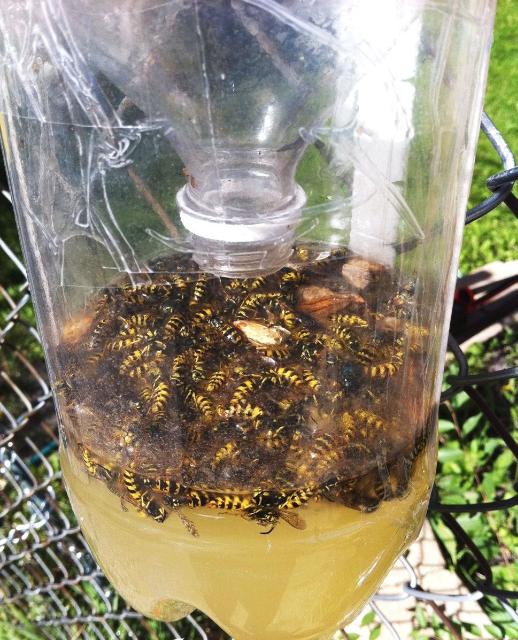
by Beth Bolles | Oct 29, 2018
As Hurricane Michael was barreling through the Panhandle region, wasp populations were at their highest of the year. Winds and flooding destroyed many of the nests of paper wasps, hornets, and yellow jackets and now wasps may be aggressive as they defend themselves or remnants of their nests. All are capable of multiple stings that are very painful. It is very likely that you will encounter stinging wasps as they scavenge for food and water, as well as seek shelter among debris and exposed trash.
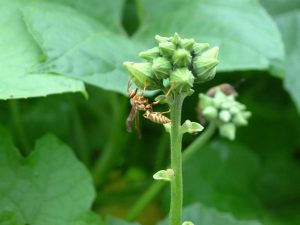
Many people are stung by paper wasps after storms. They are not attracted to traps.
Here are a few pointers to help deal with stinging wasps.
- Try not to swat at wasps flying around or landing on you. You may be less likely to receive a sting if you can flick them off.
- Some wasps are attracted to the sap from broken or recently cut trees. Look before you reach. Wear gloves and other protective clothing when moving debris in case you disturb foraging or nesting activities.
- Wasps are also attracted to sugars and water. Try your best to keep food and drink cans covered. Completely close garbage containers or bags that contain food debris.
- Repellents are not effective against wasps. There are pesticides labeled to spray on smaller paper wasp nests if you find one in a spot close to people’s activity. These are usually aerosol pyrethroids or pyrethrins. Make sure you read the label carefully and use the product as directed.
- Do not use non labeled products like gasoline to manage wasps. This is not only illegal but can be dangerous to yourself and the environment.
- There are traps for yellowjackets that you may purchase or make. These only manage those wasps flying around, not any remaining in a ground nest.
Here is a Do It Yourself Yellowjacket trap from UF IFAS Extension.
- Cut the top 1/3 off your 2 liter bottle so that you have 2 pieces.
- Add a bait (fermenting fruit or beer) to the bottom of the plastic bottle.
- Invert the top portion of the bottle into the base, forming a funnel.
- Hang or place traps so they are about 4 to 5 feet above the ground. For safety, place them away from people.
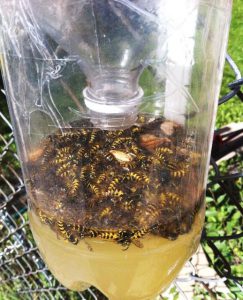
A homemade trap to catch yellowjackets. Photo by Alison Zulyniak
by Matt Lollar | Oct 20, 2018
One of my favorite native plants is winged sumac. I like this plant not only for its ornamental beauty, but also for its fruit that can be dried and used as seasoning and to make tea. So you can understand my concern when one of my prized winged sumac plants had distorted leaves.
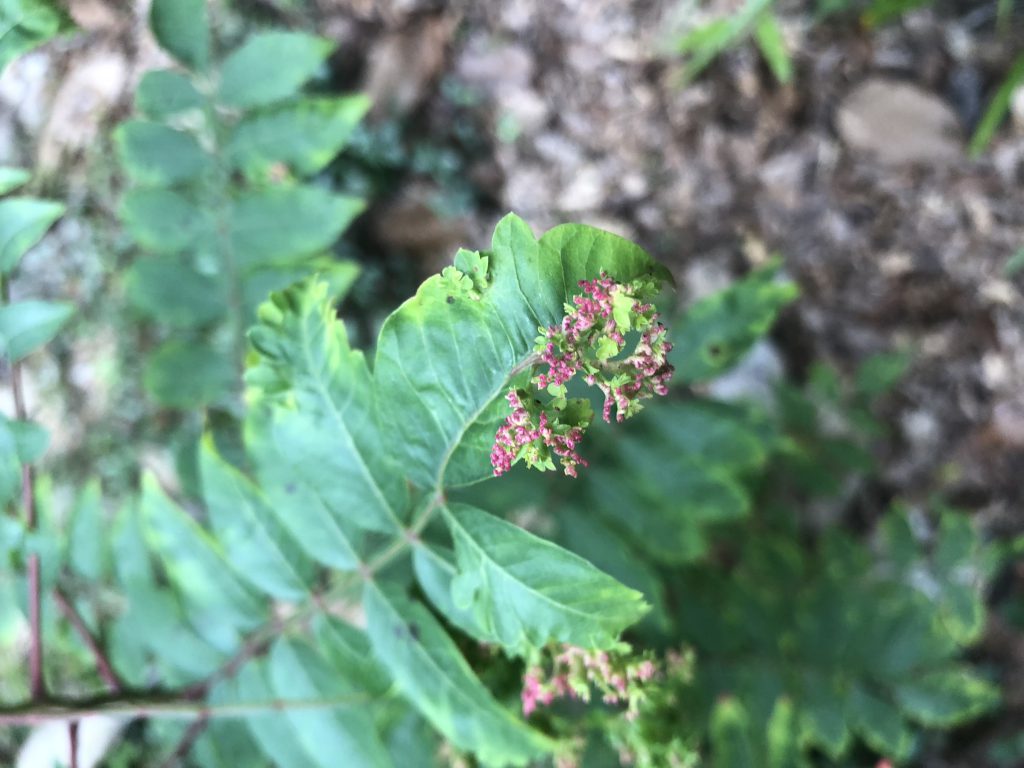
Eriophyid mite damage on winged sumac. Photo Credit: Matt Lollar, University of Florida/IFAS Extension – Santa Rosa County
After doing a little research and speaking with one of our UF/IFAS Specialists, I was able to determine that the leaf distortion was caused by eriophyid mites. Mites are not insects and are more closely related to spiders. They normally have four pairs of legs, however eriophyid mites only have two pairs of legs. They are microscopic, elongate, spindle-shaped, and translucent.

An eriophyid mite. Photo Credit: USDA, Agricultural Research Service.
Eriophyid mites cause galls (sometimes called witch’s broom) on various species of ornamental shrubs. Symptoms include early and late bud distortion, distorted leaves, and possibly plant death. In fact, the species Phyllocoptes fructiphilus is the vector for the viral disease of roses called Rose Rosette Disease. Sometimes the damage can be confused with herbicide damage.
Control options are currently being evaluated for eriophyid mites in the home landscape. Removing distorted plant material and removing it from the site can help prevent the spread of mites. If you suspect eriophyid mites are the cause of your distorted plants then samples should be collected. To collect samples: 1) Prune off symptomatic plant material and immediately place into a vial with rubbing alcohol; 2) label with collection date, plant species, and location; 3) mail to the Landscape Entomology Lab in Gainesville at P.O. Box 110620, Gainesville, FL 32611.
For more information on eriophyid mites and the sampling process, please see the fact sheet “Unusual Galls on Woody Ornamentals” from Erin Harlow and Dr. Adam Dale.
For more information on other mites that could be infesting your landscape, please go to this link from the Mid-Florida Research and Education Center in Apopka, FL.
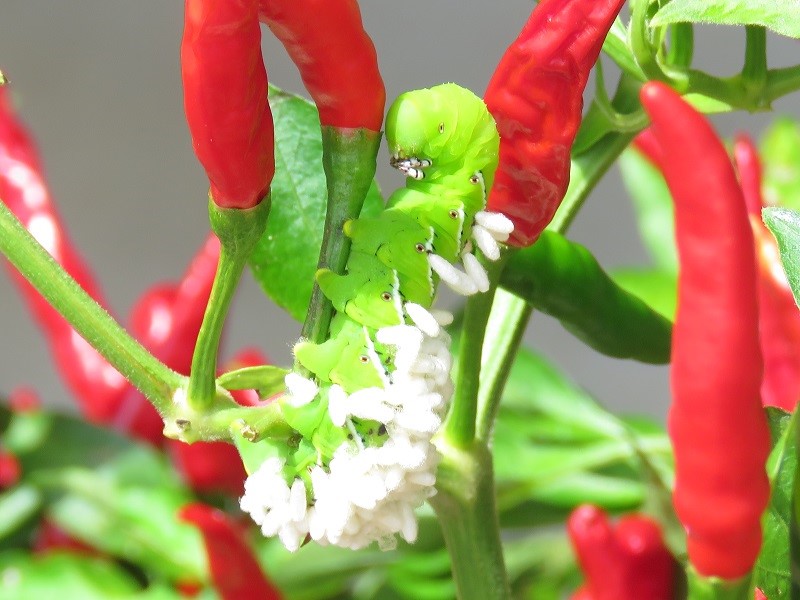
by Carrie Stevenson | Sep 18, 2018
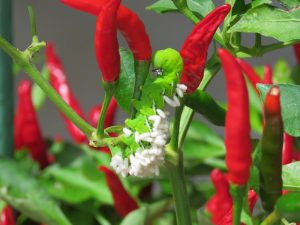
This tomato hornworm is being parasitized by beneficial wasps. Photo credit: Henry Crenshaw
Why would anyone allow dozens of wasps to thrive in their garden? Why would they let caterpillars keep moving through their pepper bushes? Don’t they know you can spray for that?
As Extension agents, one of the tenets we “preach” in gardening is the concept of Integrated Pest Management (IPM). This technique involves a series of insect control measures that begin with the “least toxic” method of control, using chemicals as a last resort. One of those least toxic measures is “biological control”, in which a natural predator or parasite is recognized and allowed to remove a pest insect naturally. It is important to be able to recognize some of the more common garden predators and parasites. Many times these insects look strange or dangerous, and they are mistaken for pests and killed.
One such beneficial insect to the home gardener is the braconid wasp (Cotesia congregatus). Most people shudder at the mention of wasps, but these tiny (1/8 inch long), mostly transparent wasps are of no danger to humans. Quite the opposite–they are an excellent addition to gardens, especially if you are growing tomatoes or peppers. One of the major pests to these favorite vegetables is the tomato hornworm (Manduca quinquemaculata), a fat green and white-striped caterpillar.
The beneficial wasp can control hornworms because females lay eggs under the caterpillar’s skin, after which the eggs hatch and larvae feed on the hornworm. After eating through the caterpillar, they form dozens of tiny white cocoons on the caterpillar’s skin. The tomato hornworm is rendered weak and near death, and the vegetable crop is saved.
If you happen to find a tomato hornworm covered in these small oval cocoons, consider yourself lucky. Let the process continue, allowing the new generation of beneficial wasps to hatch and continue their life cycle. They will control any future hornworms in your garden, and the whole process is fascinating to watch!
For questions on integrated pest management, beneficial insects, or growing peppers and tomatoes, call your local County Extension office.
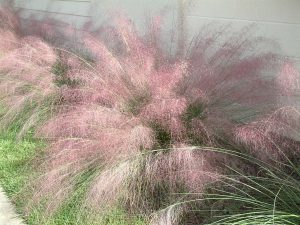
by Mary Salinas | Aug 29, 2018
Versatile, easy-care, beautiful, native – what’s not to love about muhly grass?
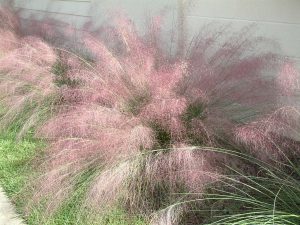
Muhly grass is a hardy landscape choice with dramatic fall blooms. Photo credit: Carrie Stevenson, UF IFAS Extension
How is it versatile? It makes a perfect border along a fence or structure. Plant it in a single or double row depending on available space. Use a single plant as a specimen in a smaller landscape. Muhly grass can also be planted in mass to serve as groundcover in a larger landscape.
What makes it easy-care? Since it only grows into a 3-foot-tall mound, there is no need to continually prune it as you would have to do for many landscape shrubs that serve a similar function. Plant muhly grass in areas where you only want to have plants grow to a 3-foot height, such as under windows or along a short fence. This clumping grass can be pruned in late winter to remove dead leaf blades, but it is not necessary. There are few pest and disease issues and its’ fertility needs are low. This tough plant can handle both drought and inundation with water. Perfect for a rain garden! Flowering is best in full sun, but it can take part sun as well.
What’s so beautiful about a grass? In the fall, abundant pink to pinkish/purple blooms cover the canopy of the grass and add color to the fall landscape. The wispy blooms move with the breezes and add interest with their movement. The new cultivar ‘Fast Forward’ blooms as early as August and into the winter. If pink is not your color, there is a form with white blooms known as ‘White Cloud’.
Consider adding some muhly grass to your landscape. You will love it as I do.
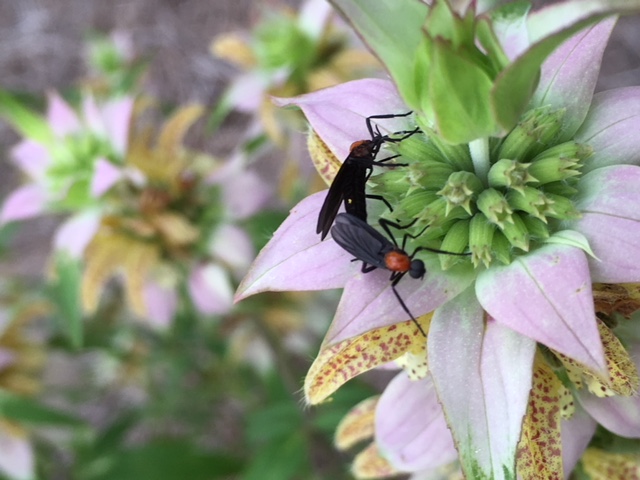
by Julie McConnell | Aug 29, 2018
In 2016, I wrote an article for Gardening in the Panhandle called “Attract Pollinators with Dotted Horsemint” introducing readers to this tough native plant that supports native pollinators. If you have flowers in your garden, you probably have pollinators and a whole lot of other insects but if you want a plant that lets you observe a really diverse palate of bugs dotted horsemint Monarda punctata.
When I find I have some downtime at home I have a habit of wandering the yard looking for interesting insects. Admittedly, I usually have my phone in hand hoping to get a great photo or video of my arthropod visitors, but it is a productive task, too. As strange as it may sound, I can count this hobby as part of my integrated pest management landscape maintenance strategy – scouting!
My favorite plant to visit on my scouting run is normally not afflicted with pests, but it hosts so many different insects it always gets a stop on my rounds. When dotted horsemint is in full flower it is visited by a lot more than pollinators. I’ve recorded daily visits from assassin bugs, ants, beetles, flies, dragonflies, spiders, thread-waisted wasps, honey bees, butterflies, and moths.
Here’s a photo album of frequent visitors to my dotted horsemint from this summer – enjoy!

by Molly Jameson | Aug 20, 2018
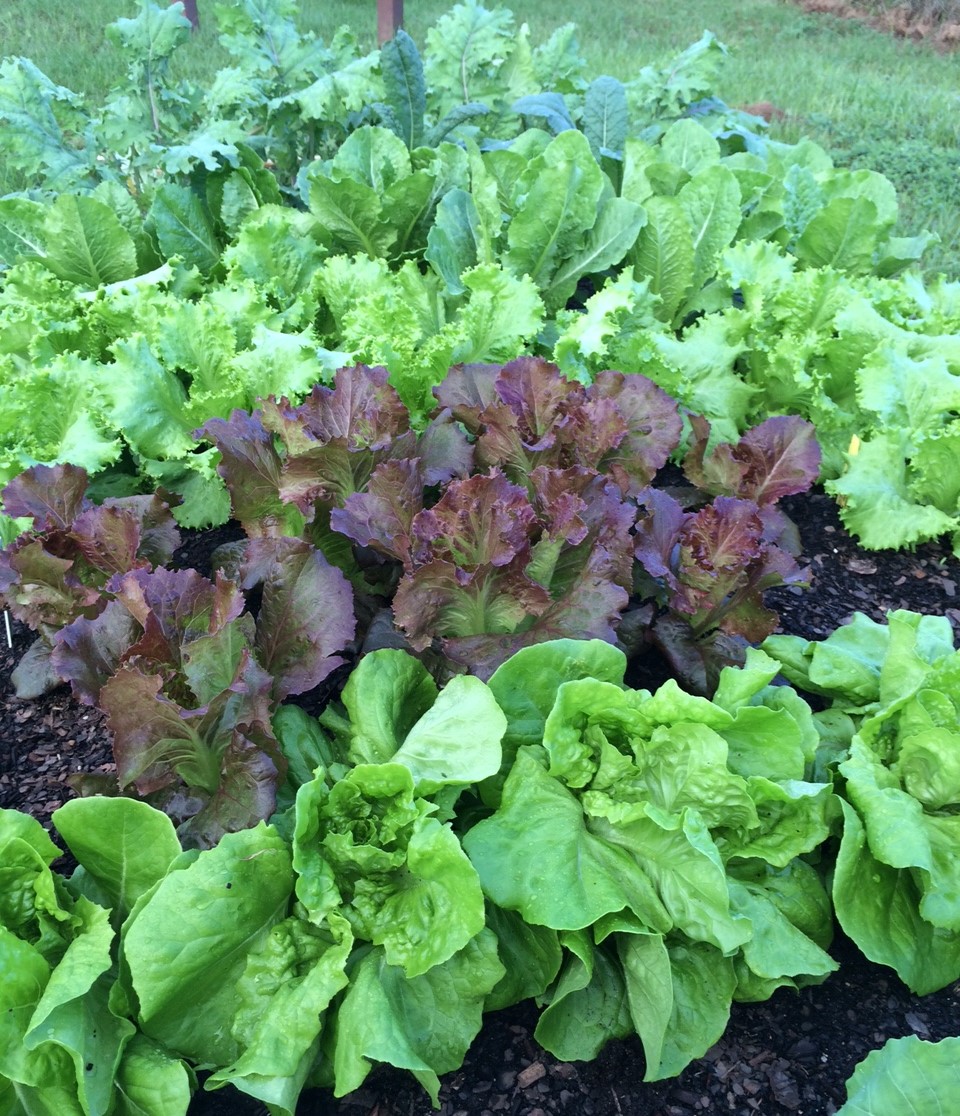
Start preparing now so your fall garden will be full of dark leafy greens, multi-colored lettuces, and root vegetables of all shapes and sizes. Photo by Molly Jameson.
August is a double-edged sword. The oppressive heat is at its pinnacle – where even the thought of spending time in the garden makes you break into a sweat – but it is also the time of year that visions of fall start coming into focus, and you can’t help but peek at the weekly forecast for signs of declining temperatures.
If your garden looks anything like mine, there are sweet potato vines weaving in and out of every corner of sunlight they can find. The sweet peppers you let fully ripen are bright red and sweeter than ever. You may have already reaped the reward of your watermelons, but you’re still hoping you can get the harvest timing right for the late season bloomers. Your okra is as tall as you – maybe even taller – and you’re grateful, for their big oblong heart-shaped leaves are shading out at least some of those warm-season weeds.
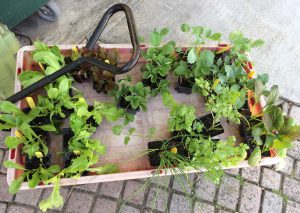
Fall is the time to start growing kale, lettuce, onions, parsley, mustard greens, and much more. Photo by Molly Jameson.
But the seasons are-a-changing, and soon you’ll be pulling up the last of your summer garden to make room for dark leafy greens, a cornucopia of roots, and a rainbow of lettuce varieties.
If this is making you want to rush to your nearest plant nursery and unearth all your half-used fall seed packets, then come on down to the Leon County Extension Office in Tallahassee to join us for our annual Fall Backyard Gardening Series!
This is a two-part series, running from 6:00 to 8:00 p.m. on September 4 and 6:00 to 8:00 p.m. on September 11, 2018, at 615 Paul Russell Road. I, along with Extension Agents Mark Tancig and Trevor Hylton, will discuss garden site selection, soil and fertilization, and fall planting and gardening techniques. As a bonus, you’ll leave with freshly planted vegetable seeds to take home to later transplant into your garden.
Please register on Eventbrite. The cost for both evenings is $10, and light refreshments will be provided. For more information, contact Molly Jameson at mjameson@ufl.edu or by phone at 850-606-5219.
And if you’re not in the Tallahassee area, check with your local extension office to see what fall gardening events they may have available. Tending a fall garden in Florida can be one of the most rewarding outdoor endeavors you can experience!













